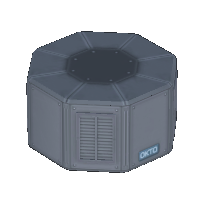Difference between revisions of "Probodobodyne OKTO"
From Kerbal Space Program Wiki
m (→link to MLI) |
AlpacaMall (talk | contribs) (small mention on its main advantages) |
||
| (11 intermediate revisions by 8 users not shown) | |||
| Line 1: | Line 1: | ||
{{:Probodobodyne OKTO/Box}} | {{:Probodobodyne OKTO/Box}} | ||
| − | The '''Probodobodyne OKTO''' is an unmanned [[command module]] that runs on [[electricity]]. | + | The '''Probodobodyne OKTO''' is an unmanned [[command module]] that runs on [[electricity]]. |
| + | |||
| + | == Product description == | ||
| + | {{Quote | ||
| + | |The OKTO is the next step in unmanned control technology. This small unit can not only receive and relay control, it also provides automatic stabilization assistance, just as a live pilot would. Also, its 8-sided stylistic design features lots of flat surfaces for attaching equipment. | ||
| + | |manufacturer=P}} | ||
== Usage == | == Usage == | ||
| − | Generally placed | + | Generally placed near the top of the rocket, the Probodobodyne OKTO provides full command module functionality and features a size-0 node on top and bottom. The low mass and cost, SAS functionality and integrated [[reaction wheel]] makes it mainly useful for basic, lightweight satellites and space probes. |
| − | |||
| − | |||
| − | |||
| − | |||
| − | |||
| − | |||
| − | |||
| − | |||
| − | + | It is the first probe core in the tech tree to have SAS functionality and an integrated reaction wheel, two notable upgrades over the low-tech [[Probodobodyne Stayputnik]]. These two features allow it to maintain a constant attitude, which can be helpful on a rocket with slightly off-center thrust. | |
== Changes == | == Changes == | ||
| − | ; | + | ;[[1.5]] |
| + | * New model and texture | ||
| + | ;[[1.2]] | ||
| + | * Added KerbNet | ||
| + | ;[[0.18]] | ||
* Initial Release | * Initial Release | ||
{{Parts}} | {{Parts}} | ||
| + | [[Category:Command modules]] | ||
Latest revision as of 04:11, 2 September 2021
| Probodobodyne OKTO | |||||
| Command module by Probodobodyne Inc | |||||
| Radial size | Tiny | ||||
| Cost | (total) | 450.00 | |||
| Mass | (total) | 0.100 t | |||
| Drag | 0.15-0.2 | ||||
| Max. Temp. | 1200 K | ||||
| Impact Tolerance | 12 m/s | ||||
| Research | | ||||
| Unlock cost | 2 800 | ||||
| Since version | 0.18 | ||||
| Part configuration | probeCoreOcto_v2.cfg | ||||
| Electricity required | 1.20 ⚡/min | ||||
| Torque | 0.3 kN·m | ||||
| Electricity required |
| ||||
| SAS level | 0 | ||||
| Field of View | (min) | 21 ° | |||
| (max) | 54 ° | ||||
| Anomaly detection | 6 % | ||||
| Enhanceable | No | ||||
| Mode | Terrain | ||||
| Antenna type | Internal | ||||
| Antenna rating | 5 km | ||||
| Packed volume | 180 l | ||||
| Electric capacity | 10 ⚡ | ||||
The Probodobodyne OKTO is an unmanned command module that runs on electricity.
Product description
| “ | The OKTO is the next step in unmanned control technology. This small unit can not only receive and relay control, it also provides automatic stabilization assistance, just as a live pilot would. Also, its 8-sided stylistic design features lots of flat surfaces for attaching equipment. — Probodobodyne Inc |
” |
Usage
Generally placed near the top of the rocket, the Probodobodyne OKTO provides full command module functionality and features a size-0 node on top and bottom. The low mass and cost, SAS functionality and integrated reaction wheel makes it mainly useful for basic, lightweight satellites and space probes.
It is the first probe core in the tech tree to have SAS functionality and an integrated reaction wheel, two notable upgrades over the low-tech Probodobodyne Stayputnik. These two features allow it to maintain a constant attitude, which can be helpful on a rocket with slightly off-center thrust.
Changes
- New model and texture
- Added KerbNet
- Initial Release
